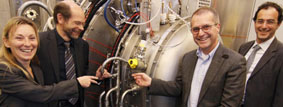 The heat source is a particle beam named Elise (Extraction from a Large Ion Source Experiment), and was unveiled at the Max-Planck Institute for Plasma Physics in Garching near Munich on 27th of November. It represents a major step forward not only in the energy of the particles, but also in the size of the beam; its cross-section is about half the area of the final models planned for ITER, reckoned as being the size of a door.
The heat source is a particle beam named Elise (Extraction from a Large Ion Source Experiment), and was unveiled at the Max-Planck Institute for Plasma Physics in Garching near Munich on 27th of November. It represents a major step forward not only in the energy of the particles, but also in the size of the beam; its cross-section is about half the area of the final models planned for ITER, reckoned as being the size of a door.
Elise is the largest device of its kind in the world, eclipsing the dinner-plate sized neutral beam heaters at JET. However it is planned to only retain that crown for the next two years, at which point MITICA, a neutral beam facility in Padova, Italy, will come online, with a full size prototype of one of ITER’s heating beams.
The successive generations of test facilities are important because ITER’s high energy beams use negative ion beams, a different technology to most existing systems. All accelerated ion beams need to be neutralised just before they enter the vessel so that they can penetrate the magnetic field. Lower energy systems, such as JET, accelerate positive ions; however positive ions present a problem because at the higher energies required to penetrate deeply into ITER’s large plasma it is almost impossible to re-attach electrons to neutralise the ions. Instead the new systems will accelerate negative ions, which are harder to create and have a very short lifetime, but have a much higher neutralisation efficiency (around 60 percent at 1 megavolt).
The ion beam is created by injecting a high frequency RF wave in hydrogen, thereby creating a plasma. This plasma is then brought into contact with a material with loosely bound electrons, for example caesium. The hydrogen picks up electrons from the material, creating negative ions, which are then separated by a complex series of water cooled grids from the other species – such as electrons, which are also negatively charged.
The Elise experiment will be conducted within IPP’s newly established “ITER Technology and Diagnostics” research division headed by Prof. Dr. Ursel Fantz.
The Max Planck Institute for Plasma Physics is one of three German signatories to the European Fusion Development Agreement.
Source: EFDA



















































































